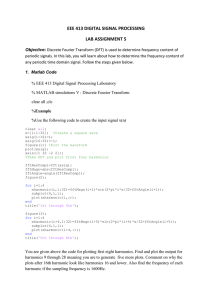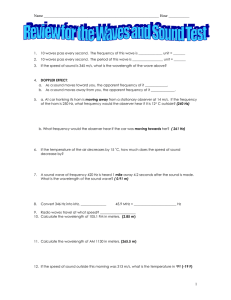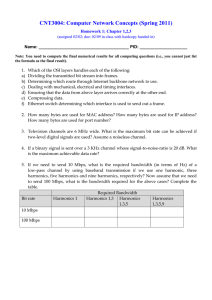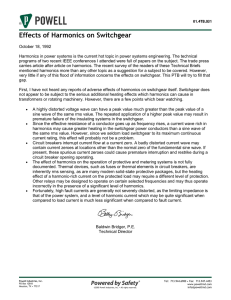9. Harmonics
advertisement
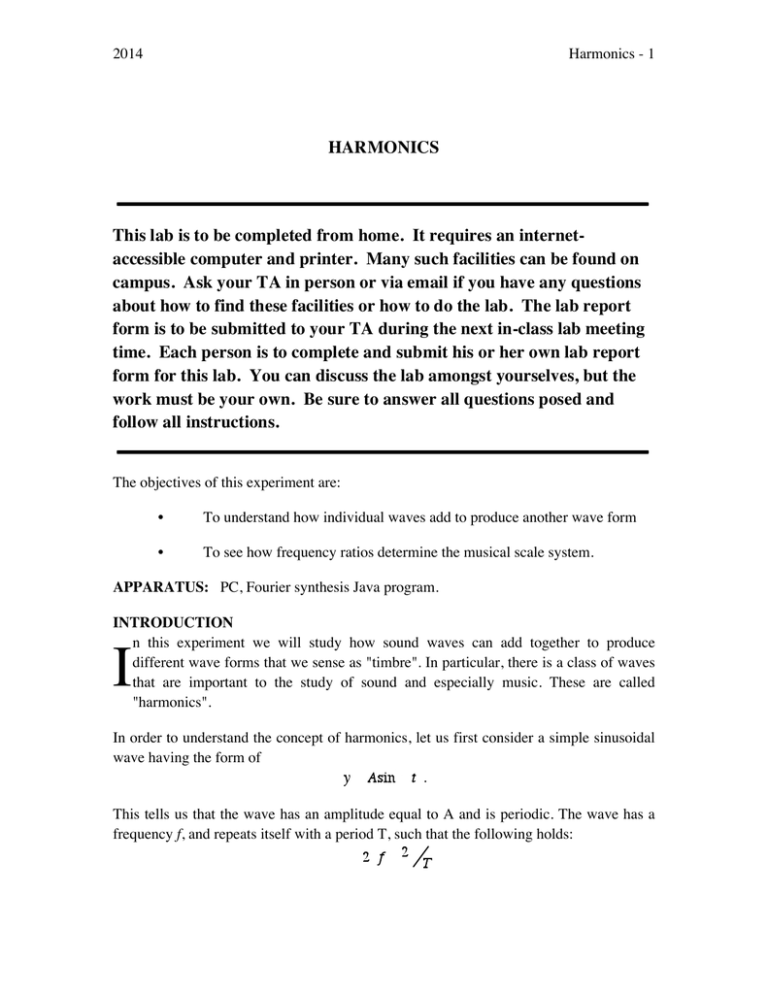
2014 Harmonics - 1 HARMONICS This lab is to be completed from home. It requires an internetaccessible computer and printer. Many such facilities can be found on campus. Ask your TA in person or via email if you have any questions about how to find these facilities or how to do the lab. The lab report form is to be submitted to your TA during the next in-class lab meeting time. Each person is to complete and submit his or her own lab report form for this lab. You can discuss the lab amongst yourselves, but the work must be your own. Be sure to answer all questions posed and follow all instructions. The objectives of this experiment are: • To understand how individual waves add to produce another wave form • To see how frequency ratios determine the musical scale system. APPARATUS: PC, Fourier synthesis Java program. INTRODUCTION n this experiment we will study how sound waves can add together to produce different wave forms that we sense as "timbre". In particular, there is a class of waves that are important to the study of sound and especially music. These are called "harmonics". I In order to understand the concept of harmonics, let us first consider a simple sinusoidal wave having the form of . This tells us that the wave has an amplitude equal to A and is periodic. The wave has a frequency f, and repeats itself with a period T, such that the following holds: 2014 Harmonics - 2 Sound waves often can be modeled by a simple sine function that describes the sound pressure as a function of time. But, even more common, we find that sound emanating from musical instruments and many other natural sources has a basic or fundamental frequency that is accompanied by other frequencies that are integer multiples of the fundamental frequency. In general higher frequencies are called overtones whether or not they are integer multiples of the fundamental. If they happen to be, then they are called harmonics. The fundamental is called the first harmonic. The next is called the second harmonic or first overtone. A sound wave comprised of a fundamental frequency accompanied by other harmonics of various amplitudes will have a certain perceptible quality to its tone called its timbre or tone color. Varying the relative amplitudes of the harmonics will change the timbre. This is why a "middle C" note played on a piano will sound different than the "middle C" note from a violin. If we analyze the spectrum of the sound wave, we can see the difference in the relative harmonics. Note that a high quality tuning fork will produce only a fundamental frequency with virtually no overtones. In other experiments you have seen how harmonics are produced whether by standing waves on a vibrating string or in a resonating tube. The physical implication is that the harmonics must be in phase. Special music synthesizers can alter the phase of harmonics which will produce different musical qualities. The frequency spectrum of a waveform during the initial moments in which a sound is heard also affects its timbre. The major factor though is simply its frequency spectrum over longer time scales. We can express a waveform F(t)simply as the series addition of harmonics: Few people are capable of recognizing the true pitch of a single musical tone, but many are able to tell what the ratio of the frequencies of two tones is. Most people can recognize that certain tones when sounded together produce a pleasing effect while other combinations give rise to an unpleasant sensation. Through experience certain frequencies have been selected to construct a musical system of pitch intervals and scales. By the term, musical interval, we mean the ratio between the frequencies of any two tones. For instance one musical sound may have a frequency of 330 Hz and another at 660 Hz. They are in a ratio of 2 to 1 which produces a very pleasant sound that is called an octave (The name originates from musical scale that divides this interval into eight tones. Octal means eight). Some of the musical intervals of the Western diatonic scale (approximate in the system of equal temperament) include: 2014 Harmonics - 3 Unison 1:1 Major Third 5:4 Octave 2:1 Minor Third 6:5 Fifth 3:2 Major Sixth 8:5 Fourth 4:3 Minor Sixth 5:3 As we said there are pairs of notes that produce agreeable sounds. There are also groups of three notes that produce similar effects. Such triads have a simple relation with the major chord being the most important. These notes are in a ratio of 4:5:6. Below is the musical scale showing the placement of the major chord on the major diatonic scale. C D 4.... .......... E ....5.... F G .......... A B C' D' ....6 4.... .......... 4.... ....5.... .......... .......... ....5.... ....6 .......... ....6 Here is the ratio of the frequencies of the major diatonic scale. f is the frequency of the initial note, in this case C, which is called the tonic. In this case, the key is C-major. Note: C Frequency f D E F G A (9/8)f (5/4)f (4/3)f (3/2)f (5/3)f B C' (15/8)f 2f The major chord involves the interval of a major third, which is usually considered to be consonant. In medieval music theory, however, this interval was considered a dissonance. This highlights the subjectivity and cultural relativity of some musical judgments. In addition to the major triad and chord there is a minor triad and chord which bear the ratio of 10:12:15. The key below is A-minor, and the general ratios for the minor scale intervals are Note: A Frequency f B C D E F (9/8)f (6/5)f (4/3)f (3/2)f (8/5)f G A' (9/5)f 2f 2014 Harmonics - 4 "FOURIER SYNTHESIS" Web Page You will use a Web Java program for this lab. This applet is located at: http://labspc200.physics.rutgers.edu/mirror/Fourier-synthesis/fourier.htm The following screen will appear. 2014 Harmonics - 5 2014 Harmonics - 6 HARMONICS PROCEDURE AND LAB REPORT FORM Name: __________________________________________________ Section: ________ A. After you have followed the above instructions to initialize the program, add a few harmonics to the fundamental frequency of a sine wave. Play it and listen to how the timbre changes as higher harmonics are added. Comment on what you hear. B. Select the Sawtooth Wave. The form of the mathematical series for the waveform is, What is the formula for An ? ___________ Play the sawtooth waveform. Then, reset the highest harmonic to zero. Play it again and take note of the change in timbre. Then, reset the next highest harmonic to zero, and listen to the resulting sound. Continue doing this until you get to just the fundamental. Record your visual and auditory observations here. C. Construct a special waveform that has harmonics of the form: where the even harmonics are zero. Watch how the waveform changes as you add each odd harmonic. Try listening to each waveform. If you had a truly infinite series, what would the waveform be? Sketch the wave form or paste a screen shot below. 2014 Harmonics - 7 D. Next repeat the previous exercise but apply harmonic amplitudes that fall off as the square of n: Watch how the waveform changes as you add each odd harmonic. Try listening to each waveform. If you had a truly infinite series, what would the waveform be? Sketch the wave form or paste a screen shot (Hint: 13 harmonics may not be enough to see the shape develop fully. You can look on the internet to see what it should converge to. Also, note that there is a difference between a Sawtooth and a Triangular wave). E. Now, zero all of the harmonic amplitudes and set the f9 and f10 to full amplitudes. Play it and listen carefully. Look at the screen. Physically speaking (i.e. in terms of wave interference), what is causing the amplitude of the waveform to increase and decrease periodically? Explain the concept of “beats” (Note: these are not “first-order” beats, which are only perceptible if the beat frequency is less than about 20 Hz). To some ears this will sound like a raspy, bad speaker; to others, a wavering sound. Sketch the wave form or paste a screen shot. 2014 Harmonics - 8 F. Finally, examine the wave forms of the musical intervals. Sketch or paste the wave form and take note of the beat pattern. Which have the most pleasant sounds? The least? Is this reflected in the wave form? (Hint: consider whether the waveform is complex or relatively simple, dense and choppy or smooth and spread out) MUSICAL INTERVAL OCTAVE FIFTH FOURTH WAVE FORM 2014 MAJOR SIXTH MAJOR THIRD MINOR SIXTH MINOR THIRD Harmonics - 9

